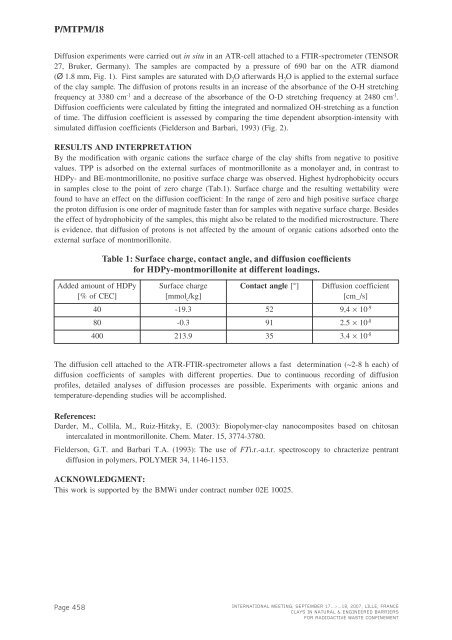Mass Transfer & Porous Media (MTPM) - Andra
Mass Transfer & Porous Media (MTPM) - Andra
Mass Transfer & Porous Media (MTPM) - Andra
You also want an ePaper? Increase the reach of your titles
YUMPU automatically turns print PDFs into web optimized ePapers that Google loves.
P/<strong>MTPM</strong>/18Diffusion experiments were carried out in situ in an ATR-cell attached to a FTIR-spectrometer (TENSOR27, Bruker, Germany). The samples are compacted by a pressure of 690 bar on the ATR diamond( Ø 1.8 mm, Fig. 1). First samples are saturated with D 2 O afterwards H 2 O is applied to the external surfaceof the clay sample. The diffusion of protons results in an increase of the absorbance of the O-H stretchingfrequency at 3380 cm -1 and a decrease of the absorbance of the O-D stretching frequency at 2480 cm -1 .Diffusion coefficients were calculated by fitting the integrated and normalized OH-stretching as a functionof time. The diffusion coefficient is assessed by comparing the time dependent absorption-intensity withsimulated diffusion coefficients (Fielderson and Barbari, 1993) (Fig. 2).RESULTS AND INTERPRETATIONBy the modification with organic cations the surface charge of the clay shifts from negative to positivevalues. TPP is adsorbed on the external surfaces of montmorillonite as a monolayer and, in contrast toHDPy- and BE-montmorillonite, no positive surface charge was observed. Highest hydrophobicity occursin samples close to the point of zero charge (Tab.1). Surface charge and the resulting wettability werefound to have an effect on the diffusion coefficient : In the range of zero and high positive surface chargethe proton diffusion is one order of magnitude faster than for samples with negative surface charge. Besidesthe effect of hydrophobicity of the samples, this might also be related to the modified microstructure. Thereis evidence, that diffusion of protons is not affected by the amount of organic cations adsorbed onto theexternal surface of montmorillonite.Added amount of HDPy[% of CEC]Table 1: Surface charge, contact angle, and diffusion coefficientsfor HDPy-montmorillonite at different loadings.Surface charge[mmol c /kg]Contact angle [°]Diffusion coefficient[cm_/s]40 -19.3 52 9,4 × 10 -980 -0.3 91 2.5 × 10 -8400 213.9 35 3.4 × 10 -8The diffusion cell attached to the ATR-FTIR-spectrometer allows a fast determination (~2-8 h each) ofdiffusion coefficients of samples with different properties. Due to continuous recording of diffusionprofiles, detailed analyses of diffusion processes are possible. Experiments with organic anions andtemperature-depending studies will be accomplished.References:Darder, M., Collila, M., Ruiz-Hitzky, E. (2003): Biopolymer-clay nanocomposites based on chitosanintercalated in montmorillonite. Chem. Mater. 15, 3774-3780.Fielderson, G.T. and Barbari T.A. (1993): The use of FTi.r.-a.t.r. spectroscopy to chracterize pentrantdiffusion in polymers, POLYMER 34, 1146-1153.ACKNOWLEDGMENT:This work is supported by the BMWi under contract number 02E 10025.Page 458INTERNATIONAL MEETING, SEPTEMBER 17...>...18, 2007, LILLE, FRANCECLAYS IN NATURAL & ENGINEERED BARRIERSFOR RADIOACTIVE WASTE CONFINEMENT
















